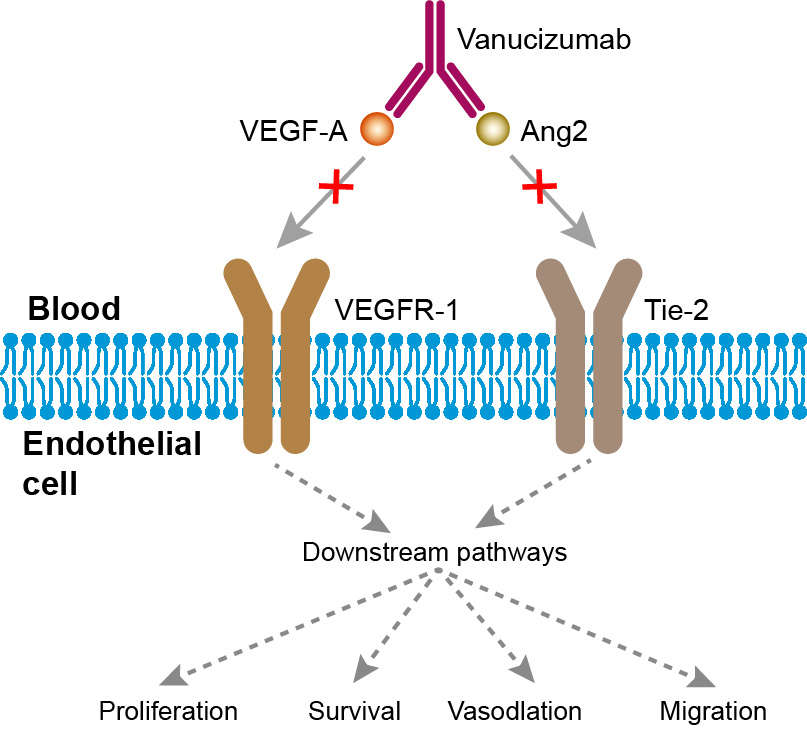Vanucizumab Overview
Introduction of Vanucizumab
Vanucizumab (RG7221) is an experimental humanized monoclonal antibody (mAb) designed for the treatment of cancer. Vanucizumab is a bi-specific mAb composed of two different heavy chains and two different light chains. One arm of the antibody binds Angiopoietin-2 (Ang2) and the other is based on bevacizumab, binding vascular endothelial growth factor A (VEGF-A). The antibody is designed to inhibit both VEGF-A and Ang2 simultaneously to offer superior clinical benefit compared to VEGF-A inhibition alone.
Mechanism of Action of Vanucizumab
Angiogenesis is a very complex and highly regulated process by which tumors larger than 1 mm are thought to develop new vasculature. This constitutes an essential feature of cancer, considering that in order for cancer cells to proliferate, a continuous supply of oxygen is needed. Without neovascularization, tumor growth is arrested. The mechanisms through which tumors acquire neovascularity are (a) endothelial ‘‘sprouting,’’ wherein normal luminal endothelial cells migrate through the basement membrane into the underlying extracellular matrix and to the tumor, developing a morphology that resembles plant sprouts; (b) co-option of pre-existing vasculature, wherein tumor cells grow around blood vessels; (c) vasculogenic mimicry, wherein aggressive tumor cells develop microvascular channels; and (d) tumor neovascularization per se, wherein the release of proangiogenic factors, such as VEGF, fibroblast growth factor, and platelet-derived growth factor (PDGF), by endothelial, stromal, and tumor cells, causes endothelial activation, vessel growth, and tumor expansion. The VEGF family (VEGF-A, VEGF-B, VEGF-C, VEGF-D, VEGF-E, and placenta growth factor 1 and 2) and their corresponding VEGF tyrosine kinase receptors (VEGFR-1, VEGFR-2, and VEGFR-3) have emerged as promising targets because they have an important role in angiogenesis and in the growth of tumors. This is especially true of serum VEGF-A, the levels of which are higher in tumor tissue than in normal tissue, specifically in cancers of the breast, lung, colon, uterus, and ovary, which has been associated with poor prognosis. When VEGF-A binds to its receptor (VEGFR-2 and less specifically to VEGFR1), it activates a signaling cascade mediated by MAP kinase and PI3K/Akt/mTOR that results in the development of angiogenesis, increased vascular permeability, and lymphangiogenesis.
Angiopoietin is part of a family of vascular growth factors that play a role in embryonic and postnatal angiogenesis. Angiopoietin signaling most directly corresponds with angiogenesis, the process by which new arteries and veins form from preexisting blood vessels. Angiogenesis proceeds through sprouting, endothelial cell migration, proliferation, and vessel destabilization and stabilization. They are responsible for assembling and disassembling the endothelial lining of blood vessels. Angiopoietin cytokines are involved with controlling microvascular permeability, vasodilation, and vasoconstriction by signaling smooth muscle cells surrounding vessels. The collective interactions between angiopoietins, receptor tyrosine kinases, vascular endothelial growth factors and their receptors form the two signaling pathways, Tie-1 and Tie-2. Angiopoietin-1 and angiopoietin-2 are modulators of endothelial permeability and barrier function. Endothelial cells secrete angiopoietin-2 for autocrine signaling while parenchymal cells of the extravascular tissue secrete angiopoietin-2 onto endothelial cells for paracrine signaling, which then binds to the extracellular matrix and is stored within the endothelial cells.
Vanucizumab binds to both VEGF-A and angiopoietin-2, and inhibits the formation of new tumour vasculature, thereby inhibiting tumour growth.
 Fig.1 Mechanism of action of vanucizumab
Fig.1 Mechanism of action of vanucizumab
For research use only. Not intended for any clinical use.
This site is protected by reCAPTCHA and the Google Privacy Policy and Terms of Service apply.



